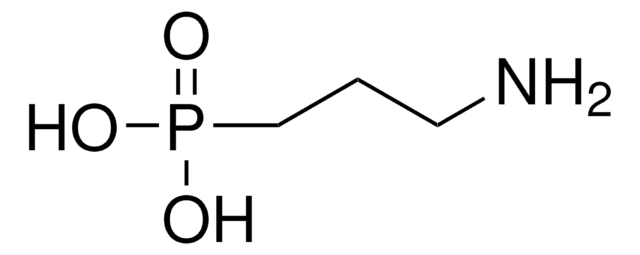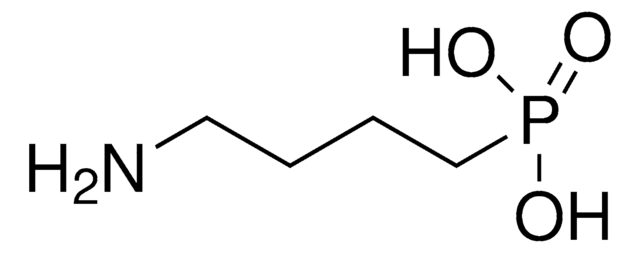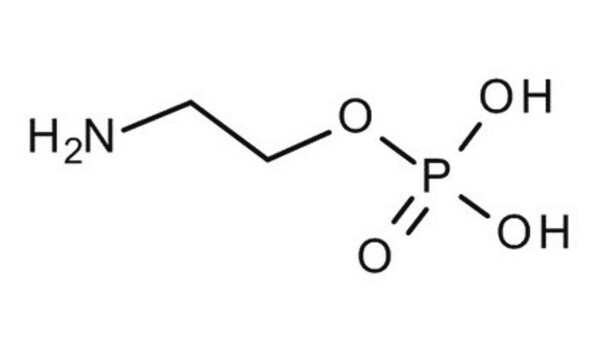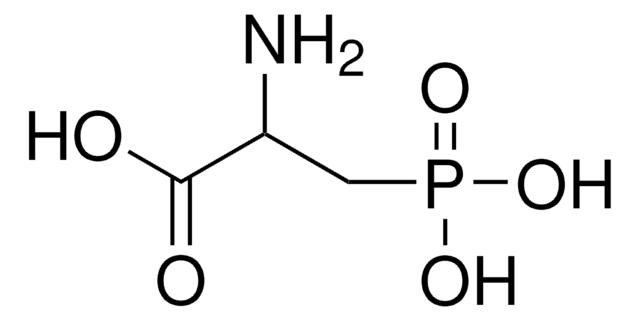268674
2-Aminoethylphosphonic acid
99%
Synonym(s):
2-AEP
Sign Into View Organizational & Contract Pricing
All Photos(3)
About This Item
Linear Formula:
H2NCH2CH2P(O)(OH)2
CAS Number:
Molecular Weight:
125.06
EC Number:
MDL number:
UNSPSC Code:
12352100
PubChem Substance ID:
NACRES:
NA.22
Recommended Products
assay
99%
form
solid
mp
296 °C (dec.) (lit.)
solubility
water: soluble 50 mg/mL, clear, colorless
SMILES string
NCCP(O)(O)=O
InChI
1S/C2H8NO3P/c3-1-2-7(4,5)6/h1-3H2,(H2,4,5,6)
InChI key
QQVDJLLNRSOCEL-UHFFFAOYSA-N
Looking for similar products? Visit Product Comparison Guide
General description
The surface of gold nanoparticles (Au NPs) were functionalized with 2-aminoethylphosphonic acid that exhibited calcium affinity which enabled targeted delivery of Au NPs to calcified tissue.
Application
2-Aminoethylphosphonic acid was used as a growth medium for the marine bacterium Roseovarius nubinhibens ISM.
signalword
Warning
hcodes
Hazard Classifications
Eye Irrit. 2 - Skin Irrit. 2
Storage Class
11 - Combustible Solids
wgk_germany
WGK 3
flash_point_f
Not applicable
flash_point_c
Not applicable
ppe
dust mask type N95 (US), Eyeshields, Gloves
Choose from one of the most recent versions:
Already Own This Product?
Find documentation for the products that you have recently purchased in the Document Library.
Customers Also Viewed
Synthesis of monensin derivatives and their effect on the activity of ricin A-chain immunotoxins.
M Colombatti et al.
Methods in molecular biology (Clifton, N.J.), 166, 55-70 (2001-02-24)
F Pessina et al.
Advances in experimental medicine and biology, 483, 325-333 (2002-01-15)
There is ample evidence that ischaemia is associated with partial denervation of the detrusor muscle and that this is responsible for much of its abnormal contractile behaviour, resulting in bladder dysfunction (instability). In guinea-pig nerves are very susceptible to the
Thomas Danhorn et al.
Journal of bacteriology, 186(14), 4492-4501 (2004-07-03)
The plant pathogen Agrobacterium tumefaciens forms architecturally complex biofilms on inert surfaces. Adherence of A. tumefaciens C58 was significantly enhanced under phosphate limitation compared to phosphate-replete conditions, despite slower overall growth under low-phosphate conditions. Replacement of Pi with sn-glycerol-3-phosphate and
Dimitrios M Kariotoglou et al.
Comparative biochemistry and physiology. Part B, Biochemistry & molecular biology, 136(1), 27-44 (2003-08-28)
The goal of this study is to supplement the composition and nature of sphingophosphonolipids diversity from edible mollusks (Mytilus galloprovincialis, Eobania vermiculata) and from jellyfish Pelagia noctiluca, organisms rich in phosphonolipids. M. galloprovincialis contained a major ceramide 2-aminoethylphosphonate (CAEP-IM) and
Celia C H Chen et al.
Biochemistry, 41(44), 13162-13169 (2002-10-31)
Phosphonates allow certain organisms to thrive in otherwise hostile environments, and 2-aminoethylphosphonate (AEP) is a precursor of many cellular phosphonates. AEP transaminase (AEPT) is an enzyme essential to phosphonate synthesis and degradation pathways. The crystal structure of AEP transaminase was
Our team of scientists has experience in all areas of research including Life Science, Material Science, Chemical Synthesis, Chromatography, Analytical and many others.
Contact Technical Service










